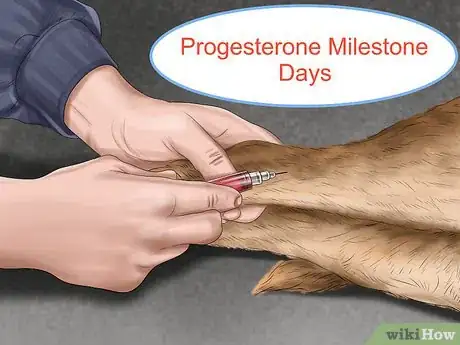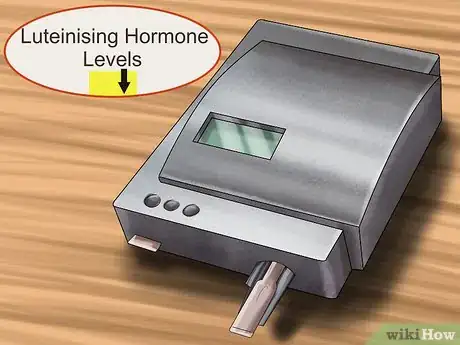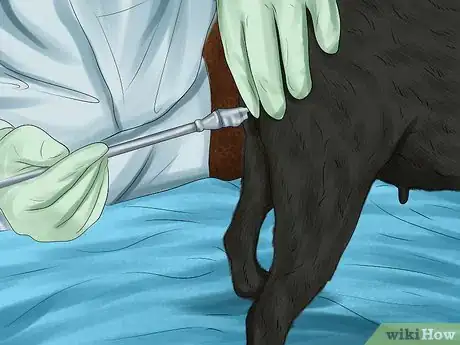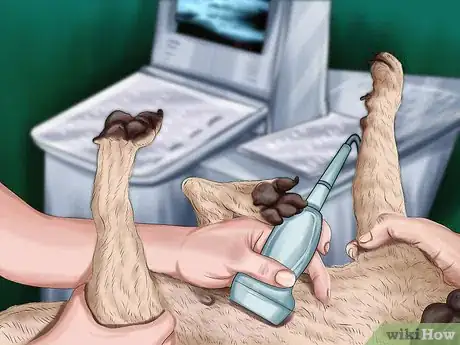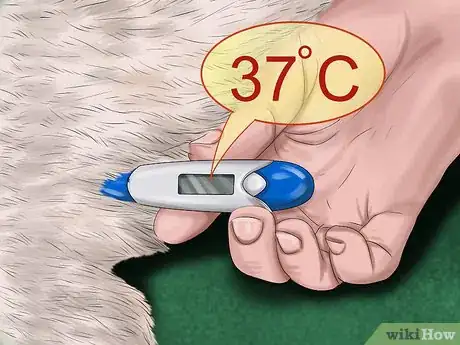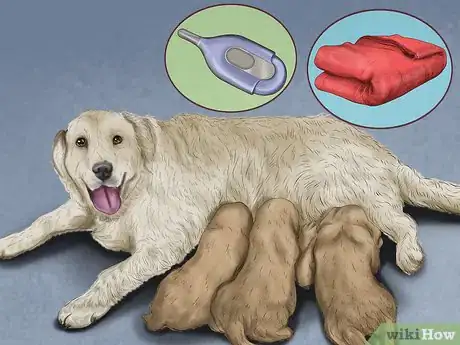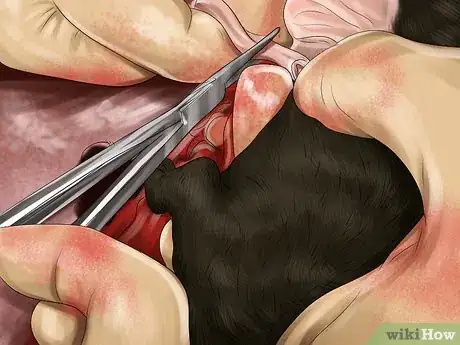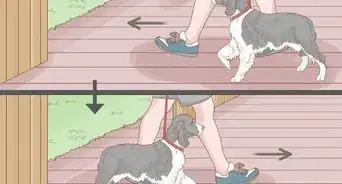This article was co-authored by Jeannie McElroy. Jeannie McElroy is a Canine Enthusiast & Breeder of Champion European Boxers under the kennel name Big Mac Boxers. With over 25 years of experience, she specializes in training, working, showing, and titling her dogs in many different types of ring sports. Jeannie is an AKC Evaluator and titles therapy dogs for Therapy Pets Unlimited. She is also a member of the AKC Bred with Heart, Greater Cincinnati Boxer Club, and US-BOX Working Boxer Association. She is passionate about the breed as she adores rearing the next generation through selectively breeding only health-tested dogs from pedigrees known to have quality genetics.
There are 12 references cited in this article, which can be found at the bottom of the page.
This article has been viewed 95,385 times.
Whelping is the term for female dogs giving birth. The average length of dog pregnancies is 63 days.[1] Being able to predict when your dog will whelp will help you prepare her and your home for the arrival of her puppies. You can make this prediction by working with your vet and looking for signs at home that your dog is about to whelp.
Steps
Getting a Veterinary Prediction
-
1Measure progesterone levels. Progesterone is the hormone that maintains pregnancy. Its levels start to rise at ovulation (ovary releases an egg to be fertilized), become higher during pregnancy, then decrease shortly before whelping. When progesterone reaches a certain level in the blood, your vet will know your dog is ovulating and predict the whelping date.[2]
- Your vet will take daily blood samples for several days to measure your dog’s progesterone levels.[3]
- Whelping will take place about 62 to 64 days after progesterone levels indicate ovulation.
- When progesterone drops at the end of a dog’s pregnancy, whelping will likely occur in one to three days.[4]
-
2Measure luteinizing hormone (LH) levels. LH is the hormone that stimulates ovulation. Its blood levels will peak at ovulation, allowing your vet to predict when your dog will whelp. However, LH levels peak for only a short period of time, so it can be easy to miss this peak.
- Because the LH peak is so short, your vet may prefer to measure only progesterone levels.
-
3Determine when your dog is in diestrus. Diestrus is the phase of a female dog’s reproductive cycle when it is out of heat. It lasts about 57 days.[5] To know when your dog is in diestrus, your vet will swab the inside of your dog’s vagina and look at the vaginal cells with a microscope.
- Vaginal cells look different in each phase of a dog’s reproductive cycle. Once the cells indicate diestrus, your vet will predict that whelping will occur in about 57 days (give or take 3 days).[6]
-
4Have your vet perform an ultrasound. After your dog is 25 days pregnant, your vet will be able to see the puppy fetuses, and even detect their heartbeats, on an abdominal ultrasound.[7] Using this information, your vet can estimate the number of days until your dog will whelp.
-
5Let your vet take x-rays. Later in the pregnancy, between days 42 and 52, your vet will be able to see the fetuses on an x-ray. Before day 42, the fetuses’ bones are not developed enough to be seen on an x-ray.[8] At this point in the pregnancy, your vet will predict that your dog will whelp in the next few weeks.
Recognizing Signs Indicating Whelping is Near
-
1Take your dog’s rectal temperature. A drop in body temperature is one of the most reliable clinical signs to use when predicting whelping. Your dog’s body temperature will drop below 99 degrees Fahrenheit/37 degrees Celsius approximately 8 to 24 hours before whelping.[9]
- Starting on day 60 of your dog’s pregnancy, take her rectal temperature twice a day.[10]
- Keep track of the temperatures in a log and watch for when her temperature drops at least 1 degree.
-
2Notice personality and behavior changes. Your dog will probably start acting differently at the end of her pregnancy. About one day before whelping, she may become restless, prefer to be by herself, and demonstrate nesting behavior.[11] Nesting behavior is when a female starts building a nest or safe area to care for her babies.
-
3Detect a decreased appetite. Dogs that are within one day of whelping will typically start eating less. This does not happen with all dog breeds, though. Your dog may continue eating as usual the day before she whelps.
-
4Examine your dog’s vulva. One day before whelping, your dog’s vulva (external part of her reproductive system) will start to swell. It may also start leaking a clear mucus.[14] You may want to put some extra blankets on your floor so the mucus does not get on your floors.
Following General Whelping Tips
-
1Prepare the whelping area. Knowing when your dog will whelp is half the battle. You will also need to prepare for the whelping process. Prepare a whelping area an area in your home where your dog can comfortably give birth and nurse her puppies. This area should be warm, quiet, and secluded. This area should also have supplies:[15]
- Rectal thermometer (and KY jelly to lubricate the thermometer)
- Blankets
- Gram scale to weigh the puppies
- Heated whelping nest
- Pen and paper to record notes about the puppies (weight, coat color, etc.) and mother
- Puppy formula and feeding tubes for puppies that aren’t nursing on their own
-
2Intervene only when necessary. Most whelpings occur without complications and without need for human intervention. In fact, too much help from you make your dog nervous about giving birth. There may be times, though, when she will need your help with the whelping process:[16]
- Tearing the placental membrane from the puppies’ mouth and nose, in case the mother is tired or inexperienced
- Rubbing the puppies with a towel until they start breathing and crying
- Using clean scissors to cut the umbilical cord to about 1/2 inch (1cm) from the puppy’s abdomen
- Tying the end of the umbilical cord with a piece of clean thread
-
3Contact your vet if there are whelping problems. If something doesn’t seem right about the whelping process, contact your vet as soon as possible. For example, call your vet if your dog is past her scheduled whelping date. Here are some other reasons to call your vet:
- Intense labor for 20 minutes, but a puppy hasn’t been delivered
- The mother develops a fever (rectal temperature above 103 degrees Fahrenheit/39 degrees Celsius)
- Bloody discharge from the mother’s vagina for 10 minutes
- Green discharge coming from the vagina, but no puppies have been delivered
Warnings
- In-home testing kits for measuring progesterone levels are not always very accurate. Do not rely only on the testing kit to predict when your dog will whelp.⧼thumbs_response⧽
References
- ↑ https://www.petcoach.co/educational-center/health/
- ↑ https://www.petcoach.co/article/how-to-choose-a-breeder/
- ↑ http://www.woodhavenlabs.com/documents/c-sections.pdf
- ↑ http://www.lowchensaustralia.com/breeding/monitoring.htm
- ↑ http://www.peteducation.com/article.cfm?c=2+2109&aid=3201
- ↑ http://www.woodhavenlabs.com/documents/c-sections.pdf
- ↑ http://www.labbies.com/reproduction1.htm
- ↑ http://www.labbies.com/reproduction1.htm
- ↑ https://www.merckvetmanual.com/management-and-nutrition/management-of-reproduction-small-animals/whelping-and-queening
- ↑ http://www.lowchensaustralia.com/breeding/monitoring.htm
- ↑ http://www.michigananimalhospital.com/page/421552100
- ↑ http://omalmalamutes.com/omal/falsepregnancy.htm
- ↑ https://www.vetwest.com.au/pet-library/pregnancy-and-your-dog-an-overview
- ↑ https://www.vetwest.com.au/pet-library/pregnancy-and-your-dog-an-overview
- ↑ http://www.akc.org/content/dog-breeding/articles/planning-your-bitchs-c-section/
- ↑ http://www.rentonvet.com/whelping-period.php
- ↑ https://www.merckvetmanual.com/management-and-nutrition/management-of-reproduction-small-animals/whelping-and-queening
About this article
To predict when your dog will whelp her puppies, monitor her rectal temperature, which will drop below 99 degrees Fahrenheit approximately 8-24 hours before whelping. Additionally, keep an eye on her vulva, which may start leaking a clear fluid about a day before she’s ready to deliver her puppies. You should also make note of changes in her behavior, like becoming restless or dragging blankets or papers to a quiet area of the house, about a day before she’s ready to whelp. For more information from our Veterinary co-author, including how to prepare a whelping area for your dog, read on!
